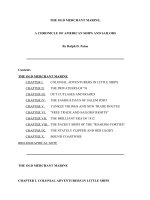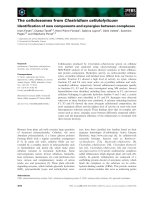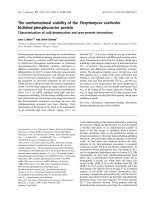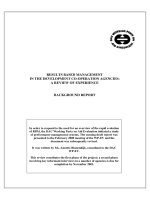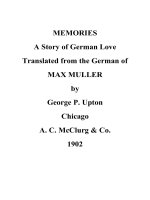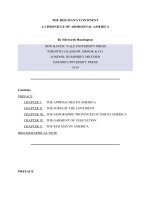CIA at war (english)
Bạn đang xem bản rút gọn của tài liệu. Xem và tải ngay bản đầy đủ của tài liệu tại đây (10.36 MB, 95 trang )
Dedicated to the families of CIA officers,
past and present.
Authors
Ursula M. Wilder
Toni L. Hiley
Tracey P.
Peter Garfield
Project Leader
CIA Museum Curator
Graphic Designer
Photographer
The authors thank the numerous dedicated people whose time and talents made this publication possible. All contributors were united by
their pride in CIA’s history and mission and by their desire to support and thank our families. The outcome is, in the best tradition of CIA,
the result of many hands and many hearts giving without expectation of rewards other than those that are found in service to others.
CIA AT WAR
Studies in Intelligence is a quarterly publication prepared primarily for the use of US government officials.
This book is a supplementary issue. Its format, coverage, and content, as with all issues of Studies,
are designed to meet the requirements of US government officials. All statements of fact, opinion, or
analysis expressed in this publication are those of the authors. They do not necessarily reflect official
positions or views of the Central Intelligence Agency or any other US government entity, past or present.
Nothing in the contents should be construed as asserting or implying US government endorsement of
factual statements, interpretations, or recommendations.
Issues of Studies often contain material that is protected by copyright. Such items are marked
and attributed and should not be reproduced and widely disseminated without permission.
Editorial Policy
Studies in Intelligence is produced by the Center for the Study of Intelligence. CSI’s core
mission is to enhance the operational, analytical, and administrative effectiveness of the
CIA and the Intelligence Community by creating knowledge and understanding of the
lessons of the past, by assessing current practices, and by preparing intelligence officers
and their organizations for future challenges.
Articles for Studies in Intelligence may be written on any historical, operational,
doctrinal, or theoretical aspect of intelligence.
Editorial Board
Peter S. Usowski, Chairman
Andres Vaart, Editor
Ursula M. Wilder, Guest Editor
Pamela S. Barry
Nicholas Dujmovic
Eric N. Heller
John McLaughlin
Philip Mudd
Wayne M. Murphy
Matthew J. Ouimet
Valerie O. P.
Michael Richter
Michael L. Rosenthal
Barry G. Royden
Not listed are three members who are under cover. Members of the board are drawn from
the Central Intelligence Agency and other Intelligence Community components.
iv
CIA at WAR
Design
Multimedia Communications Group
Directorate of Science and Technology
vii........................ Letter from the Director
xi......................... Introduction from the Office of Public Affairs
Part 1
CIA at War: A Photographic Essay
3.............Prologue
6 ............Office of Strategic Services - World War II
8.............Tradecraft Tools - Cold War
10...........Mission - Vietnam
12...........Flag - Beirut
14...........Shell - Balkans
16...........Husband and Wife - Africa
18...........The President’s Briefer - 11 September 2001
20...........Nurse - Worldwide
22...........Team Alpha - Afghanistan - October 2001
24...........Warrior - Afghanistan, Iraq, Worldwide
26...........Logistics in Action - Iraq
28...........Partners - Worldwide
30...........Tech Ops - Worldwide
32...........Case Officer - Worldwide
34...........Calligrapher - Headquarters
Part 2
Museum Curator’s Notes
TABLE OF CONTENTS
Table of Contents
39...........Historical Background
Part 3
Reflections on Our Officers in War
65...........Tempered by Fire: The Lives of CIA Officers in War
77...........Epilogue: Two Letters
CIA at WAR
v
CIA AT WAR
Leon Panetta Director, Central Intelligence Agency
vi
CIA at WAR
LETTER FROM THE DIRECTOR
From the very founding of our Agency, the men and women of CIA have
served in places of danger. When the United States military is engaged in battle,
intelligence is there to provide essential support. Those who make policy in
our country count on CIA to be their eyes and ears in the world. In conflicts of
every kind, our government has turned to our Agency to gather vital information
and advance America’s interests.
Much has changed in the world in the past six decades. But difficult missions still
come here. Skill and courage remain in demand. Commitment and loyalty
continue to thrive. And, far more often than not, the work of this Agency is done
quietly, with precise knowledge of success and sacrifice confined to a relative
few. Those are just some of the constants of CIA at war.
The regions where our officers deploy are some of the toughest on the planet.
There, they face more than physical hardship and separation from loved ones.
They see the unforgiving side of these struggles—the loss, the waste, and the cruelty
of those we fight. Generations of American intelligence officers, like generations of
Americans in uniform, have emerged from the strife changed in ways both subtle
and profound.
I have seen in the war zones and in those who have served there an unbeatable
commitment to mission and to colleagues. The premium is on getting the job
done, as quickly and efficiently as possible. The emphasis is on team work, with
close cooperation across directorate and agency lines a daily fact of life. It is
that spirit, energy, and dedication that must flow through every part of this great
organization.
Those who have answered the call of duty represent the best of us, and they
deserve the best from us. From many backgrounds, they came together, under
stress exceptional even in the world of intelligence, to do what had to be done.
CIA at WAR
vii
CIA AT WAR
In them, pride and grief sometimes coexist—pride in decisive accomplishments,
grief for those whose lives were taken in the most noble of causes. Recognizing
what they have done is not an obligation. It is a privilege.
The strains of service in zones of war and unrest are borne not just by those who
go abroad, but by those who await their return. The hardship is as real as the
honor. The requirements of patience, strength, and perseverance apply to all.
To those who shoulder the risks and meet the obstacles, we owe our love,
understanding, and support.
This book is dedicated to them and to their families, to those my son—who
served in Afghanistan—calls the “silent warriors.” It is a tribute to valor, endurance,
and devotion, qualities that are found in this Agency on days both ordinary and
extraordinary. That, in many ways, is the lesson of both our past and our present,
and a sure sign for our future.
viii
CIA at WAR
Leon Panetta
Director, Central Intelligence Agency
KRYPTOS
“Kryptos” by James Sanborn Central Intelligence Agency Courtyard
CIA at WAR
ix
CIA AT WAR
x CIA at WAR
an organization critical to America’s security. While many details of its activities
are, of necessity, kept from the public at large, the operations of this Agency are
carefully overseen inside our government, oversight that is absolutely crucial to the
necessary and well-earned place of foreign intelligence in a healthy, open society.
From every part of that society come the men and women who do the work
of intelligence for the CIA and the nation it so proudly serves. Like America
herself, they defy stereotype, reflecting an enormous range of experiences and
perspectives. As this book makes clear, they and the loved ones who support them
share what counts most—a faith in the principles that define our country and a
readiness to promote and defend them. That is the core requirement of service
with CIA, no matter the place or conditions of assignment. The responsibilities are
always real and often unique.
• Part One—CIA at War: A Photographic Essay—speaks to the passion and valor
of those drawn to the tough, exacting field of intelligence and espionage.
• Part Two—Museum Curator’s Notes—speaks to the history of CIA, with
its lessons of preparation, persistence, and ingenuity, frequently in the face of
long odds and daunting obstacles.
• Part Three—Reflections on Our Officers in War—speaks to the strengths of those
who accomplish the mission in zones of conflict, and the strains that can come
with duty there.
The United States expects much from those who act in secret on behalf of the
American people. For this Agency, that secrecy is a grant not of power, but of
trust. CIA at War is designed to provide a glimpse, a snapshot, of how we strive, in
situations of stress and hazard, to earn and exercise that trust.
INTRODUCTION FROM THE OFFICE OF PUBLIC AFFAIRS
CIA at War is meant, above all, to be a window into the people and culture of
CIA at WAR
xi
PART ONE
xii
CIA at WAR
CIA AT WAR
A Photographic Essay
CIA at WAR
1
A PHOTOGRAPHIC ESSAY
CIA Memorial Wall Original Headquarters Building
2
CIA at WAR
portraits of CIA men and women as well as still-life photographs of historical
artifacts. The story begins in WWII and continues through the present.
While the poses in the portraits and the still-life arrangements were orchestrated
by our photographer, the people and objects are authentic. Portrait subjects
dressed in their own clothes and were photographed holding the tools they used
PROLOGUE
The following photographic essay tells a story of CIA officers in war. It contains
or personal items from the wars and conflict zones they served in. The still-life
tableaux were composed of objects from CIA’s museum and private collections.
The curator’s notes that follow the photographic essay describe the use and
provenance of the objects shown and also as much of their history as can be
revealed of the people in the portraits.
As a young man our photographer, Peter Garfield, served with the US Army
in Vietnam as a combat photographer. In the course of his work during that
war Peter had occasion to fly on CIA’s “Air America” and to observe CIA
officers in action. His commission for this book was to use his art to reveal
the heart of CIA’s people and to show our continuity with past generations
of officers and families who have served in wars. He could not reveal the
identities of most of the people in his portraits, but while interacting with
them he learned about their work and their service in war. His response to
CIA’s people and history is evident in the artistry he brought to creating
this photographic essay.
After completing his work, Peter reflected on the experience in the
following way:
The people before me had moving, heroic, and compelling stories. Their stories
were personal but also symbolic of many others at the Agency. As I met with
CIA at WAR
3
A PHOTOGRAPHIC ESSAY
each person, it became evident through a gesture, a body inflection, and the
inclusion of a significant object or item that he or she would reveal something
uniquely personal and human yet also universal about the Agency.
The reverence with which a retired officer held the flag that covered the casket
of a colleague’s repatriated remains, the natural tenderness of the embrace
between husband and wife as they posed for a photograph, a towel fluttering in
the wind, a dog’s leash, sheet metal, wires and a dusty welder’s helmet, maps
and compasses carried in wars 50 years apart, a calligrapher’s hands with her
tools nearby—all of these were ordinary people and objects, but the story they
tell is sublime.
4
CIA at WAR
Ursula Wilder
Toni Hiley
Project Leader
CIA Museum Curator
PROLOGUE
CIA at WAR
5
OFFICE of STRATEGIC SERVICES
World War II
“I have often felt that the true act of heroism occurs when a person volunteers
for a dangerous mission in the first place. Later on, when the mission itself is
under way, all sorts of irresistible factors come into play that require a man to
behave bravely—peer pressure, instinct for survival, or solidarity with comrades in
dangerous circumstances. But in the tranquility of an office, before any of these
factors begin to have any force, a man does measure his courage and decide
whether he is willing to risk his life, and why.”
6 CIA at WAR
William Colby, commenting in his autobiography on his service for OSS,
leading paramilitary missions behind enemy lines at age 24. In 1973 he
became the 10th Director of Central Intelligence.
CIA at WAR
7
TRADECRAFT TOOLS
Cold War
“We were going up against the very best. Lives depended on our skills, training,
technique, tools, and tradecraft. There was literally no room for error. The pressure
was intense. We would practice day and night for weeks; it had to be perfect
every time. We had to be quick and leave no trace. If we failed, people whom
we had never met but who were risking their lives for us would die. It was certain.”
8 CIA at WAR
Senior Directorate of Science & Technology officer on
conducting technical operations in the Cold War era.
CIA at WAR
9
MISSION
Vietnam
“Mr. James A. Monroe braved heavy enemy fire from elements of two Viet Cong
battalions while conducting two rescue missions to evacuate American civilians
trapped in the city….Over the remaining course of the battle, Mr. Monroe provided
overall direction and intelligence support to units engaging Viet Cong in the city.
The conspicuous courage of Mr. Monroe at the risk of his own life was in keeping
with the highest traditions of our service and our Nation.”
From the Citation for the Distinguished Intelligence Cross.
“Staff Sergeant Drew D. Dix distinguished himself by exceptional heroism...while
serving as a unit adviser…personal heroic actions resulted in 14 confirmed Viet
Cong killed in action and possibly 25 more, the capture of 20 prisoners, 15
weapons, and the rescue of the 14 United States and Free World civilians. The
heroism of Sergeant Dix was in the highest tradition and reflects great credit
upon the United States Army.”
10 CIA at WAR
From the Citation for the Medal of Honor.
CIA at WAR
11
FLAG
Beirut
“I do not go one week without seeing those wives—and the kids who were
there—when I told them they were widows. Their faces, their eyes…they know,
before you tell them, why you are there.”
12 CIA at WAR
Counterintelligence officer on notifying family members of the death
of an officer in the line of duty.


